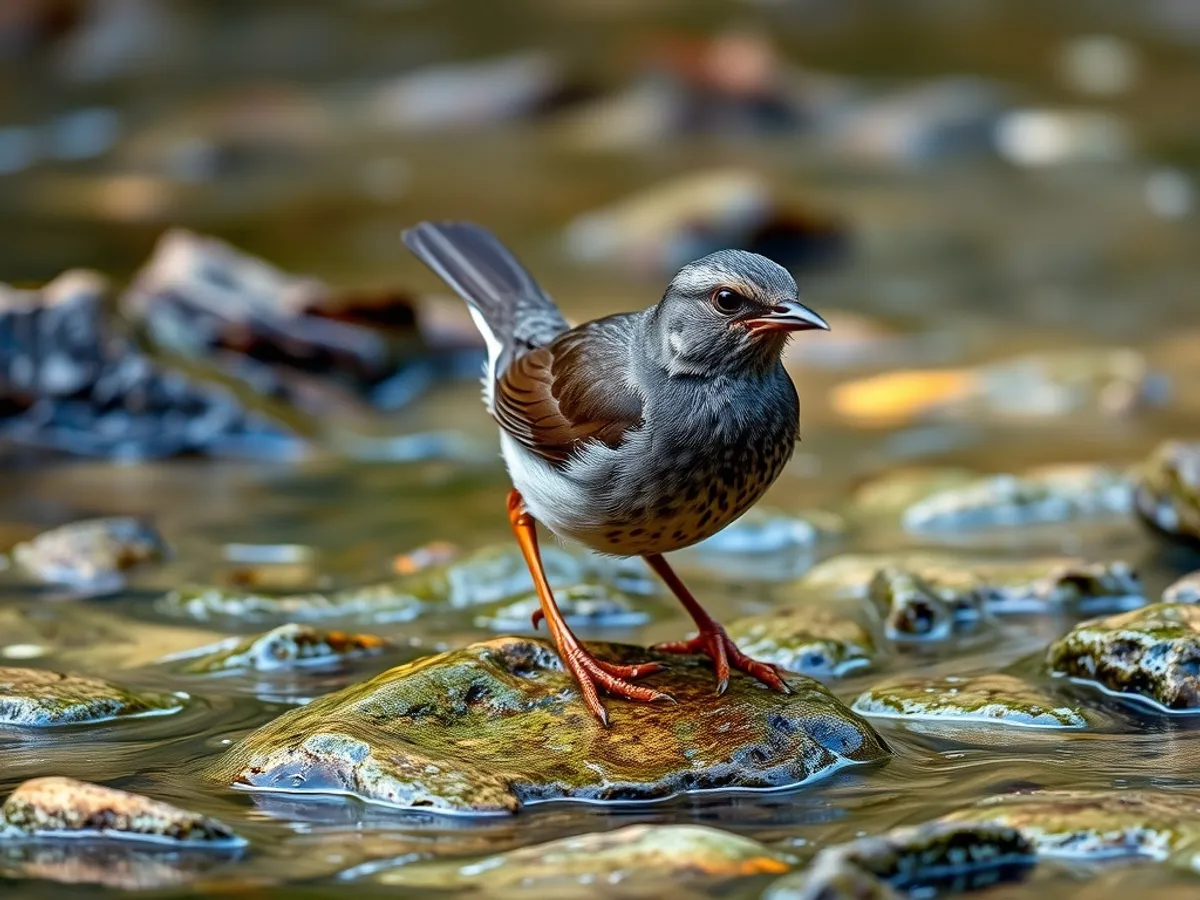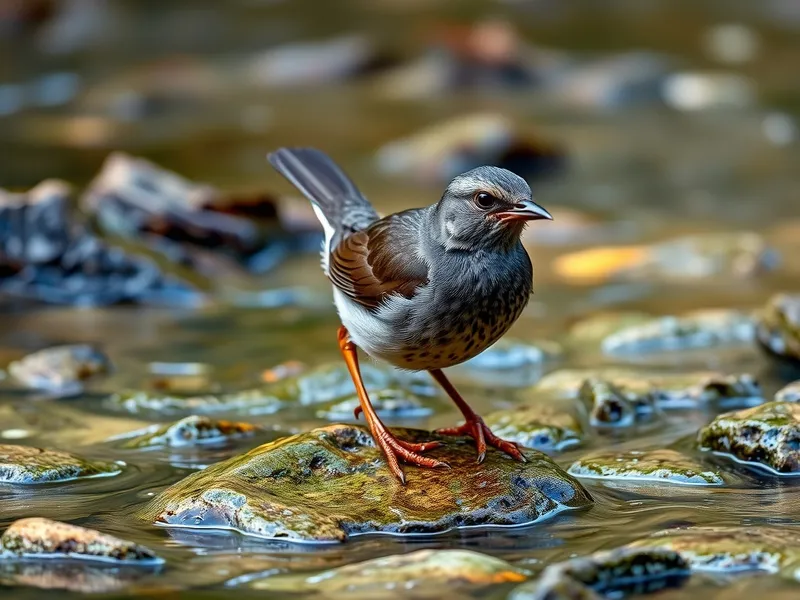
American Dipper
Cinclus mexicanus

Meet the American Dipper
The American Dipper is a stout, slate-gray songbird uniquely adapted to life along fast-flowing, cold mountain streams in western North and Central America. Notable for its bobbing or 'dipping' motion, this bird can walk underwater in search of aquatic insects and larvae, thanks to its strong legs and dense plumage. It is the only aquatic songbird native to North America, and its presence is often an indicator of clean, healthy river ecosystems. The American Dipper's melodic song can be heard year-round, even in the harsh conditions of winter.
Classification
Bird
Habitat
Mountain streams and rivers
Diet
Carnivore
Lifespan
5-7 years
Conservation
Least Concern
Weight
46-61 grams
📖Fascinating Facts
Aquatic Forager
The American Dipper feeds primarily on aquatic insects, larvae, and small fish, diving and walking underwater to catch its prey.
Cold Water Resident
This hardy bird remains along icy streams year-round, often enduring freezing temperatures and snowy conditions that drive other birds to migrate.
Powerful Song
Despite the roar of rushing water, the American Dipper's song is loud and melodious, helping them communicate over the noise of their habitat.
📋Detailed Description
The American Dipper (Cinclus mexicanus) is a robust, medium-sized passerine measuring 14–20 cm (5.5–7.9 in) in length and weighing 46–62 g (1.6–2.2 oz). Its plumage is uniformly slate-gray, sometimes with a brownish tinge, and it features a short tail, long legs, and a distinctive white eyelid that flashes when it blinks. The bill is straight and relatively short, adapted for probing underwater. Unlike most songbirds, the dipper has dense, waterproof feathers, a thick layer of down, and large preen glands that produce oils for waterproofing. Its wings are short and rounded, providing agility rather than distance in flight. The American Dipper is highly territorial, defending stretches of stream year-round. It is renowned for its characteristic bobbing or 'dipping' motion, the function of which is still debated but may relate to communication or prey detection. This species is largely solitary outside the breeding season, and its presence is a reliable indicator of unpolluted, well-oxygenated streams. The dipper’s song is a loud, melodious series of whistles and trills, audible even over the roar of mountain rapids.
💡 Did you know?
Unlike most songbirds, the American Dipper can swim and even walk along the bottom of swift streams, using its wings for balance underwater.
🔬Research & Sources
Wikipedia Summary
The American dipper, also known as a water ouzel, is a semiaquatic bird species native to western North America.
Last Modified: 5/19/2025
🎭Behavior & Social Structure
American Dippers are diurnal and spend most of their time foraging along fast-flowing streams. They hunt by diving into the water, swimming with their wings, and walking along the streambed to search for aquatic insects, larvae, small fish, and crustaceans. Their foraging technique is unique among North American songbirds, involving frequent submersion and the use of their strong legs and sharp claws to cling to rocks underwater. Dippers are highly territorial, with individuals or pairs defending linear stretches of stream against conspecifics. Social interactions are generally limited to courtship and parental cooperation during breeding. Outside of the breeding season, dippers are solitary. They maintain a regular daily routine of foraging interspersed with periods of preening and singing from prominent perches. During winter, they remain active, often breaking through ice to access flowing water.
👶Reproduction & Life Cycle
Breeding typically occurs from late April through July, varying with altitude and latitude. American Dippers are monogamous, with pairs forming long-term bonds that may persist across seasons. Courtship involves aerial chases, singing, and mutual displays. Nests are globular structures made of moss, grass, and leaves, usually built on rocky ledges, under bridges, or behind waterfalls, always near running water. The female lays 2–5 white eggs, which she incubates for 13–17 days. Both parents feed the altricial chicks, which fledge at about 18–25 days old. After fledging, parents may continue to feed the young for several days. Pairs may raise two broods per season if conditions are favorable.
🛡️Adaptations & Survival
The American Dipper exhibits a suite of remarkable adaptations for aquatic life. Its dense, waterproof plumage and large uropygial gland help maintain insulation and buoyancy in cold water. The bird’s blood has a high hemoglobin concentration, allowing efficient oxygen transport during underwater foraging. Nostrils can close to prevent water ingress, and the eyelids have a white, semi-transparent nictitating membrane for underwater vision. Strong legs and long toes enable the dipper to grip slippery rocks and walk along streambeds. Behaviorally, the dipping motion may serve to improve prey detection by reducing surface glare or to signal territory ownership. The species’ ability to forage in freezing conditions is facilitated by physiological tolerance to cold and behavioral strategies such as frequent preening and selecting ice-free feeding sites.
🎨Cultural Significance
The American Dipper holds a special place in the folklore and natural history of western North America. Indigenous peoples and early naturalists recognized its unique aquatic habits and regarded it as a symbol of purity and resilience. The dipper has been featured in regional literature and is the official bird of the Yukon Territory, Canada. Its presence is often celebrated by anglers and conservationists as a sign of healthy rivers. The bird’s remarkable adaptations and behavior have inspired both scientific study and artistic representation.
🔬Recent Research & Discoveries
Recent research on the American Dipper has focused on its role as a bioindicator for freshwater ecosystem health, with studies correlating dipper abundance and reproductive success to water quality and aquatic insect diversity. Genetic studies have clarified its relationship to other Cinclus species and revealed low genetic differentiation across its range. Ongoing research is examining the physiological mechanisms underlying its cold tolerance and diving abilities, as well as the impacts of climate change and habitat alteration on population dynamics. Notably, studies using radio telemetry and stable isotope analysis have provided new insights into dipper movement patterns, diet, and territory size. Conservation biologists continue to use the species as a model for understanding the effects of environmental stressors on riverine birds.
🎥Wildlife Videos

American Dipper Songbird of the River. #Americandipper
Spent the last few weekends recording these fantastic little birds as they surf, dance, and dive along the Molalla river in Oregon.
Wildlife Theater

American Dipper | 4K
Along the Gardner River in Yellowstone's northwest corner, an American dipper "dips" in and out of the rapids as it forages.
Kyle Dudgeon Creative

Dippers - A Most Unique Bird
Dippers are the only bird that can walk on the bottom of fast moving streams where they find aquatic insects and the occasional ...
Epic Nature Judy Lehmberg

American Dipper | Meet the Water Ouzel
There are five species of dippers in the world. Aside from the American Dipper in North America, there is the white-throated dipper ...
All Things Birdie

An American Dipper Family
The first day we viewed this American Dipper family, there were three chicks, and one parent actively feeding the chicks. But only ...
Ray H

American Dipper (Cinclus mexicanus)
Birds In Motion
🌍Habitat Information
The American Dipper typically inhabits Mountain streams and rivers environments. American Dippers have adapted to their environments with specialized features and behaviors.
Primary Habitat:
Mountain streams and rivers
More detailed habitat information will be available soon.
🛡️Conservation Status
The American Dipper is currently classified as Least Concern. Conservation efforts are crucial for preserving this species for future generations.
Common Threats:
- 🏠Habitat loss and fragmentation
- 🌡️Climate change impacts
- 🎯Hunting and poaching
- 🏭Human-wildlife conflict
⚠️Threats & Conservation Challenges
While currently listed as Least Concern by the IUCN, the American Dipper faces several localized threats. Water pollution, siltation, and stream channel modification from logging, mining, agriculture, and urbanization degrade habitat quality and reduce prey availability. Dams and water diversions alter stream flow and temperature, impacting breeding and foraging. Climate change poses additional risks by affecting snowmelt patterns and stream hydrology. Insecticide runoff can reduce aquatic insect populations, a primary food source. Despite these challenges, populations remain stable in many regions, largely due to the species’ preference for remote, undisturbed habitats. Long-term monitoring is essential, as the dipper’s sensitivity to water quality makes it an important bioindicator species.
🔬Scientific Classification
Scientific Name
Cinclus mexicanus
Classification Hierarchy
🔍 About Taxonomic Classification
Taxonomic classification is a hierarchical system used by scientists to classify and organize living organisms based on shared characteristics and evolutionary relationships.
The system moves from broad categories (Kingdom) to increasingly specific ones, with each animal's scientific name typically consisting of its Genus and species.
📝Community Notes
Share your observations and insights about the American Dipper with our community of wildlife enthusiasts.
Join Our Community
Sign in to share your observations and connect with fellow wildlife enthusiasts.
Sign In to ContributeNo community notes yet
Be the first to share your observations about the American Dipper!
Explore American Dipper
Select a tab above to learn more about this amazing animal.
📸Photo Gallery
No photos available for this animal yet.
🌟Discover More Wildlife
Continue your journey of discovery with more fascinating animals from our database
